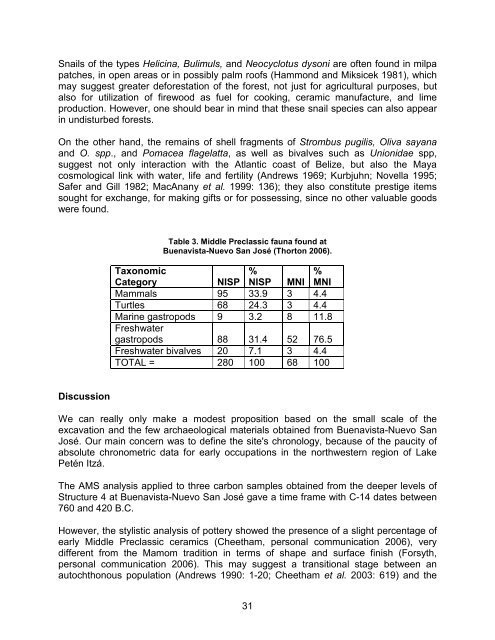Buenavista-Nuevo San José, Petén, Guatemala: Another ... - Famsi
Buenavista-Nuevo San José, Petén, Guatemala: Another ... - Famsi
Buenavista-Nuevo San José, Petén, Guatemala: Another ... - Famsi
You also want an ePaper? Increase the reach of your titles
YUMPU automatically turns print PDFs into web optimized ePapers that Google loves.
Snails of the types Helicina, Bulimuls, and Neocyclotus dysoni are often found in milpa<br />
patches, in open areas or in possibly palm roofs (Hammond and Miksicek 1981), which<br />
may suggest greater deforestation of the forest, not just for agricultural purposes, but<br />
also for utilization of firewood as fuel for cooking, ceramic manufacture, and lime<br />
production. However, one should bear in mind that these snail species can also appear<br />
in undisturbed forests.<br />
On the other hand, the remains of shell fragments of Strombus pugilis, Oliva sayana<br />
and O. spp., and Pomacea flagelatta, as well as bivalves such as Unionidae spp,<br />
suggest not only interaction with the Atlantic coast of Belize, but also the Maya<br />
cosmological link with water, life and fertility (Andrews 1969; Kurbjuhn; Novella 1995;<br />
Safer and Gill 1982; MacAnany et al. 1999: 136); they also constitute prestige items<br />
sought for exchange, for making gifts or for possessing, since no other valuable goods<br />
were found.<br />
Table 3. Middle Preclassic fauna found at<br />
<strong>Buenavista</strong>-<strong>Nuevo</strong> <strong>San</strong> <strong>José</strong> (Thorton 2006).<br />
Taxonomic<br />
Category<br />
NISP<br />
%<br />
NISP MNI<br />
%<br />
MNI<br />
Mammals 95 33.9 3 4.4<br />
Turtles 68 24.3 3 4.4<br />
Marine gastropods 9 3.2 8 11.8<br />
Freshwater<br />
gastropods 88 31.4 52 76.5<br />
Freshwater bivalves 20 7.1 3 4.4<br />
TOTAL = 280 100 68 100<br />
Discussion<br />
We can really only make a modest proposition based on the small scale of the<br />
excavation and the few archaeological materials obtained from <strong>Buenavista</strong>-<strong>Nuevo</strong> <strong>San</strong><br />
<strong>José</strong>. Our main concern was to define the site's chronology, because of the paucity of<br />
absolute chronometric data for early occupations in the northwestern region of Lake<br />
<strong>Petén</strong> Itzá.<br />
The AMS analysis applied to three carbon samples obtained from the deeper levels of<br />
Structure 4 at <strong>Buenavista</strong>-<strong>Nuevo</strong> <strong>San</strong> <strong>José</strong> gave a time frame with C-14 dates between<br />
760 and 420 B.C.<br />
However, the stylistic analysis of pottery showed the presence of a slight percentage of<br />
early Middle Preclassic ceramics (Cheetham, personal communication 2006), very<br />
different from the Mamom tradition in terms of shape and surface finish (Forsyth,<br />
personal communication 2006). This may suggest a transitional stage between an<br />
autochthonous population (Andrews 1990: 1-20; Cheetham et al. 2003: 619) and the<br />
31
















